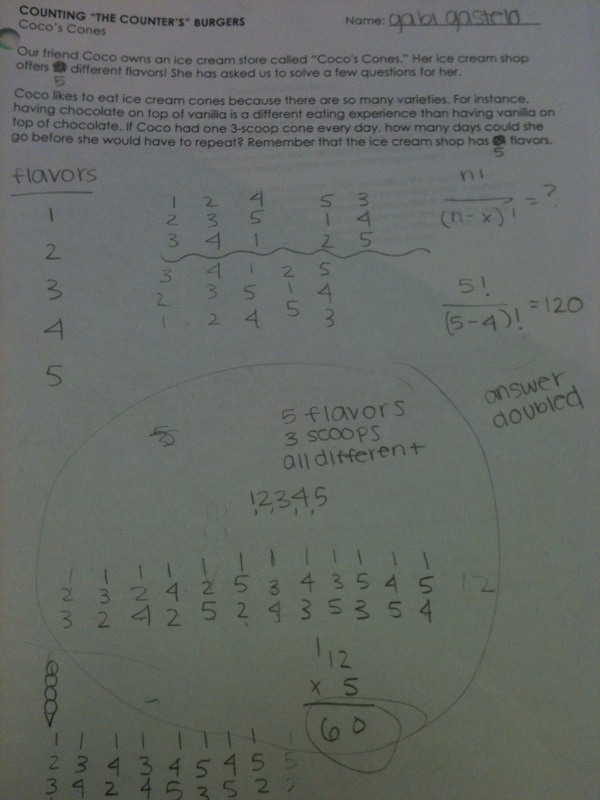1. Describe the task or activity that you were working on.
In the problem "coco's cones" we were asked to find how many different 3 scoop ice cream cones we could make with 5 different flavors. We were also given the information that vanilla, strawberry, and chocolate was different than chocolate, strawberry, vanilla. I tackled this problem by seeing how many different cones I could make with just flavor one on the top. I came up with twelve different options. I then figured that if I multiplied this number by how many flavors there were, which is 5, I would get the answer to the problem, which is 60. Coco can make 60 different ice cream cones.
2. How is your work here representative of this habit? Identify specific parts that show the "habit in action."
This particular problem is hard to figure out just by looking at it. It looks overwhelming and difficult to tackle. I was extremely confused until Mr. Meyer helped me by suggesting I try simplifying it by counting the amount of cones with flavor one. After I tried this, the whole problem clicked in my head and I had a full understanding.
3. (Answer one) How was this habit useful in helping you make progress with the task or activity? If it was not useful, how might you revise your use of this habit so that it was useful?
This habit was very useful in the process of solving the task. If I didn't simplify the problem before trying to tackle it, It would have taken me a very long time to get a grip on the problem.
In the problem "coco's cones" we were asked to find how many different 3 scoop ice cream cones we could make with 5 different flavors. We were also given the information that vanilla, strawberry, and chocolate was different than chocolate, strawberry, vanilla. I tackled this problem by seeing how many different cones I could make with just flavor one on the top. I came up with twelve different options. I then figured that if I multiplied this number by how many flavors there were, which is 5, I would get the answer to the problem, which is 60. Coco can make 60 different ice cream cones.
2. How is your work here representative of this habit? Identify specific parts that show the "habit in action."
This particular problem is hard to figure out just by looking at it. It looks overwhelming and difficult to tackle. I was extremely confused until Mr. Meyer helped me by suggesting I try simplifying it by counting the amount of cones with flavor one. After I tried this, the whole problem clicked in my head and I had a full understanding.
3. (Answer one) How was this habit useful in helping you make progress with the task or activity? If it was not useful, how might you revise your use of this habit so that it was useful?
This habit was very useful in the process of solving the task. If I didn't simplify the problem before trying to tackle it, It would have taken me a very long time to get a grip on the problem.

 RSS Feed
RSS Feed